Are you using the right knife for the right task? Which task are you performing? And does it require a certain type of knife? Knife choices vary vastly from person to person, which is why knife manufacturers and makers provide a never-ending supply of different knives for customers. A person’s choice of knife is highly personal, and emotions sometimes run strong for that given choice.
Will just any knife do? Let’s dive into the subject of choosing the right one.
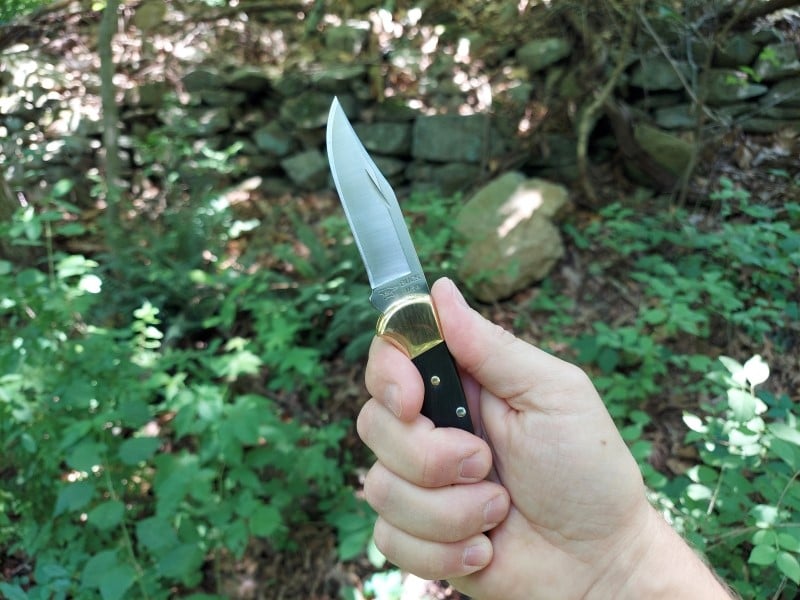
What do you need to do with your knife?
Many of us carry knives on the job to complete various tasks. Perhaps you work in a grocery store and cut a lot of cardboard. Maybe you’re a rancher and oversee livestock. Or you’re a farmer and work with machinery in the fields. Doctors, lawyers, office executives, landscapers, delivery drivers—there are so many different careers out there, it’s bewildering. Many have similar tasks in common while others couldn’t be more different.

At one point or another, many of us have purchased a knife without a lot of thought as to how effective it will be for our uses. Sometimes we get lucky, other times it doesn’t work out as well. And, although we love to use our knives every chance we get, sometimes another tool is appropriate.
To decide which blade(s) you want, take an honest assessment of what you use your knives for daily. Some jobs call for a very durable knife with a lot of cutting power. For some, perhaps a fixed blade is appropriate. Other occupations might be served best by a small, lightweight folding knife.
For example, a box cutter might serve a person working in a grocery store that has to break down several dozen boxes in a short time. The box cutter has disposable blades that are easily changed and will save wear and tear on a favorite knife. The right tool for the job often wins out.
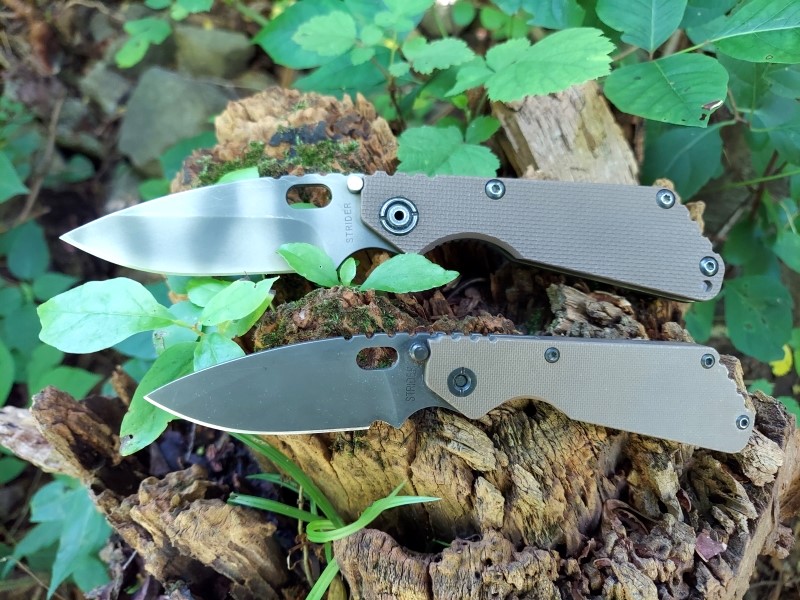
For me, and many of my knife-obsessed friends, a huge factor in the enjoyment of collecting knives is seeking that Perfect Knife, the One that will “do it all.” I’m not sure if that Magical One knife actually exists, but damn if I’m not having fun trying to find it!
I’m going to try to break down the use categories into some very basic ideas. These will be far from all-encompassing, but I’ll do my best to hit some of the high points.
Also, it’s important to point out that many of the knives that I list here can perform double or triple duty, excelling at several roles. Some will fill every role mentioned because they’re just all-around great blades that can do it all. Personally, I love a knife that can fill any role because I feel like I’m getting the best bang for my buck and also that I’m always prepared for any eventuality.
Choosing an EDC Knife
Every Day Carry (EDC) has become a standard catchphrase these days. To me, it means a general-use knife (or in my case, knives) I have clipped to my pant pockets for daily tasks like opening mail and boxes, cutting string/twine/paracord, opening the huge bag of dog food that my pet beasts eat so much of each week, and slicing shrink wrap from pallets at work. There seem to be a hundred different tasks that fall into the EDC category—and hundreds of different knives from which to choose.

It’s a great time to be alive as a knife aficionado these days! Knife manufacturers and designers keep us well supplied with more knife designs than we can even count. I consider myself to be fairly knowledgeable on the knives that are available, but I am still bewildered at the selection that’s out there. I often see new designs that I had no idea existed—which is a wonderful thing.
EDC Knife Characteristics
Generally, for an EDC knife, I look for something with a 3.5-inch blade or less. I’ve been known to carry larger ones, but for what I do, the shorter blades work very well. I enjoy blades that have a drop point, and sometimes a clip point, although I’m also open to others because variety is the spice of life.
I like a knife that clips to my pants pocket because it makes it easy for me to access it quickly and easily. I do carry other knives that don’t clip to my pocket, but I’ll almost always have at least one clipped to my pocket.
That said, I’ve recently gotten into Buck Knives, and am currently carrying one in a belt pouch (the 112 folding Ranger) in addition to the knives clipped in my pockets. I find it to be a refreshing change of pace.
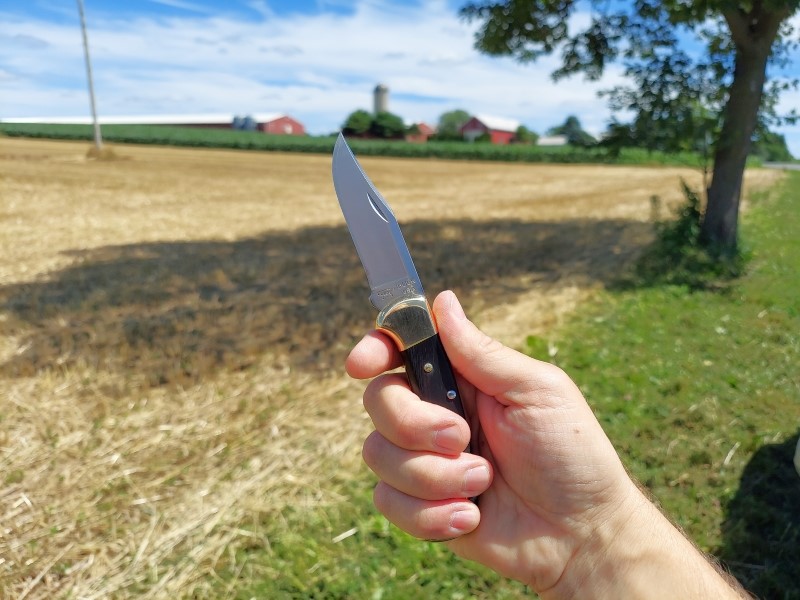
I’m a fan of opening holes, specifically the ones used on Spyderco. Strider also uses an oval opening hole that’s awesome. Thumb studs on blades and opening discs like Emerson uses are always favorites too. All of these make one-handed opening a snap, which I consider to be essential because sometimes I’m holding something in my other hand.

My EDC Knives
I’ll list some knives that I’ve found work wonderfully for EDC. This list is nowhere near all-inclusive. It’s just a bunch of knives that appeal to me and I’ve accumulated over the years, in no particular order.
Spyderco Paramilitary 2
The PM2 has a 3.42-inch long blade that has a sort of leaf shape to it. It’s a full flat grind (FFG) and slices like crazy. The blade is S30V on mine, although they make them in many steels these days, depending on the batch/run they’re doing. The handle is black G-10.
These days, this is about as large as I normally carry daily. It has the characteristic opening hole and is amazingly fast into action. The lock is the Spyderco Compression Lock, which I love because it lasts forever and is super reliable.

For well over a year, this knife has been my daily workhorse for EDC. It will fill quite a few other roles too, being at home in the woods, hunting, or for self-defense. It’s just practical for all sorts of tasks and is one of the most versatile knives that you can own. The PM2 can be had in a lightweight version with an FRN handle or in a standard G-10 version, with a plain edge or partially serrated. The price, at the time of writing, is around $175.00.
Spyderco Native
With a spearpoint blade that’s just under three inches (2 7/8″), this compact knife is a gem of a workhorse that I also carry daily (usually teamed up with the PM 2 or Para 3, depending on my mood). The Native uses a lock back, which is one of the strongest and most reliable locks on the market.

This is one of Spyderco’s enduring designs. It was introduced in the 1990s and is still going strong, which is not surprising considering it’s solid, useful design. The Native can be had in the Lightweight version complete with FRN handle or in a G-10 handled version (I own a few of both versions). Serrated, partially serrated, and plain edge blades are also options.
I’m prejudiced on this one, as it is one of my favorite knife designs on the planet. This is another knife that can fit into numerous roles. It fits in at the office, on the ranch, or gutting a deer. In a pinch, it could also be used for defense.
Although it’s not a large knife, it performs out of its weight class—like a much larger knife because of its wide blade and Full Flat Grind (Newer models have FFG, older models are hollow ground). The common steels available these days are S30V or S35VN, although Spyderco commonly does runs in other blade steels. The Native can be had for as little as around $120 at the time of this writing.
Spyderco Lil’ Native
I guess you’re seeing a trend by now with the Spyderco routine, eh? There’s a good reason for that. They offer excellent knives at good prices. The Lil’ Native is the smaller brother of the regular Native, and sports a 2 3/8″ blade that can be either plain or serrated. Another very cool feature is that they are made in both lock-back and compression-lock versions. I have examples with both locking mechanisms and love both.

The Lil’ Native is at home where smaller cutting tasks are appropriate. It’s nice for the office environment because it doesn’t tend to alarm people, given its small size. It sports an FFG, which helps the blade to really slice well. It’s a stout, little folder with a G-10 handle. The price at the time of writing is around $142.
Spyderco Para 3
This is PM 2’s little brother. Para 3 has a blade length of three inches and the most common steel for this knife is S30V. It can be had with G-10 handles or the lightweight version has FRN (Fiberglass Reinforced Nylon). The Para 3 utilizes the compression lock that works so well. There are plain-edged versions as well as SE (Spyder Edge) serrated versions.

I have two Para 3’s: both are the Lightweight (LW) models, and one is plain edge, the other is SE, both in CTS- BD1N steel. The serrations cut with insane ferocity. Like many of the others, this knife can fill several roles, from hunting to self-defense and everything in between. The LW version can be picked up for as little as $115 at the time of writing.
Buck 110 Folding Hunter
This old classic has been going strong since 1963! It says a lot when a design endures for such a long time and people are still buying it up like hotcakes.
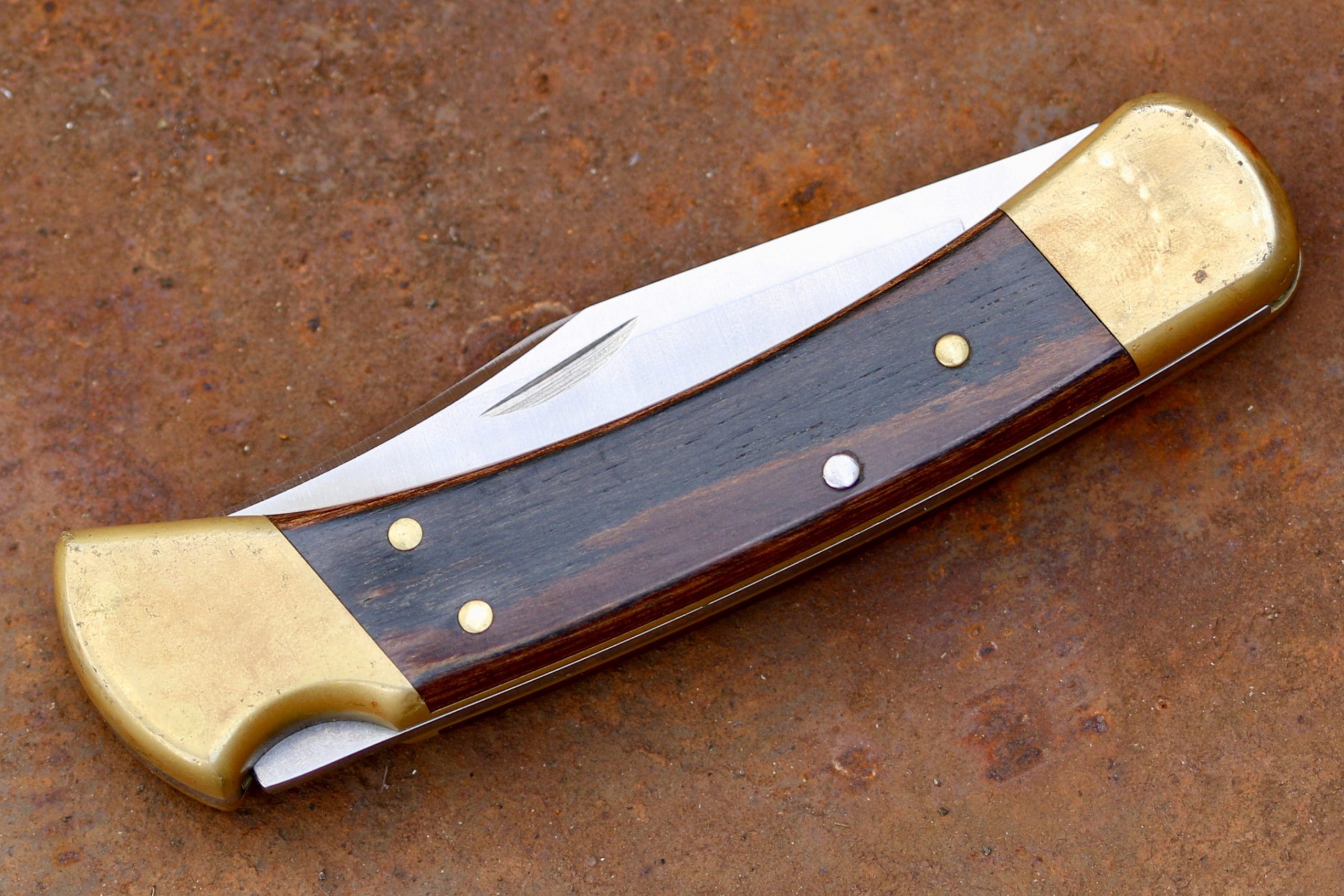
The 3 3/4″ hollow ground blade is made from 420HC steel. The locking mechanism is a lock back, which is very sturdy. Since Buck calls it the Folding Hunter, the implications are pretty clear which category this one is intended for. However, it rides on the belts of thousands of Americans in rural America and sees use for every imaginable task under the sun each day (it comes with a leather belt pouch sheath). Sure, it’s great for skinning game, but it will cut most materials that you’d have occasion to cut in your everyday travels.
The classic materials used, including Ebony handle with brass bolsters, make for a good looking knife. The original version has a clip point, but it can now also be purchased in a drop point version. Retail at the time of writing is $59.95, which is a real bargain, considering the materials and quality that you’re getting.
Buck 112 Ranger
This is a slightly smaller version of the Buck 110. The blade is three inches of 420HC and is a clip point. As an option, a drop point bladed model is also available.

The Ranger turns 50 this year, and the one I recently purchased has a “50” on the blade, denoting this special birthday. As with other Buck Knives, the lock-back design of this folder is rock solid and reliable. It comes with a belt sheath of heavy leather that is nicely built. Although of a hunting design, this knife is at home doing almost any other task you can throw at it. For me, it’s the perfect size for EDC tasks. Retail at the time of writing is $59.95.
Strider SnG
Strider originally built its knives for military applications. Over the years, people have realized that the overbuilt tanks that Strider calls knives also work great for EDC and other categories. The SnG blade is 3.375 inches long, making it a great length for the majority of jobs. The Titanium frame lock is super tough, as is the G-10 scale that comprises the other side of the knife’s handle.

This knife isn’t cheap, but it’s nearly indestructible. It comes in a variety of blade grinds, including FFG, hollow grind, and a 3/4 grind (which is shown here). It is also made in several blade steels, including S30V. Price is typically in the $450-ish range. Strider’s lifetime warranty is hard to beat.

Strider PT
This is the smaller version of the SnG, with a blade length of around 2.5 inches. It has the same handle design as the SnG, with Titanium and G-10 for supreme strength. To be honest, this little knife handles so many EDC tasks, it’s amazing.

While the blade length might sound short on paper, in real life, it addresses so many cutting tasks with perfection. The drop point, FFG blade is a superb cutter. Strider does its knives in runs, so colors and steels vary from run to run. Price is $350 at the time of writing.
KaBar Dozier Folder
This one is a practical, very low cost folder from KaBar, designed by knifemaking legend Bob Dozier. The blade is three inches long and made from AUS-8A steel. While it’s not the greatest steel, the knife comes very sharp from the factory and cuts well. The lock back is very secure and reliable. The handle is made from Zytel and comes in a variety of colors.

Overall, it’s extremely light and when it’s clipped into the pocket, the user forgets that the knife is even there until it’s needed. The reversible pocket clip adds versatility. I’d love one of Dozier’s custom knives, but that’s not in the cards at the moment, so this knife designed by him is the next best thing (and it is a superb design). One of the best parts about this knife is that it’s just a shade over $20 as this is written. You can buy a few of these knives and if one gets lost or somehow broken, you’re not out much money. For a budget-friendly knife, this one is great!
Spyderco Techno 2
This little guy is nicely dressed up for the office environment (though it’s tough enough to function anywhere). It’s very nicely finished and looks great. It sports a Titanium frame lock with standoffs that are a pleasing light green color.

Although the blade is only 2.52 inches long, it’s built like a tank and plenty sharp, with a blade of CTS-XHP steel that holds an edge for a long time. The lockup is very solid and you can’t help but fall in love with the workmanship that has gone into this knife. The non-reflective finish of the Ti handles is pleasing to the eye as well, and the blade wears a tumbled finish. The street price on this one is $230 as this is written, but it’s well worth it.
There are easily hundreds more knives that I could pile into this category, but space will not even come close to allowing this.
Survival and Bushcraft Knives
In this department, I don’t want my primary knife to be a small folder, but rather a fixed blade (though I’ll carry at least one smaller blade as a backup). It doesn’t have to be a huge knife but should be stout enough to take some abuse. I’ll use it for tasks like gathering wood for shelter and a fire, and whittling fuzz sticks to make a fire. It’s possible I’ll use it to Notch wood for building a shelter, along with a ton of other woodland tasks.
Ontario TAK
This fixed blade is 4.6 inches long and made from 1095 steel. The handle is canvas micarta, and it’s a generous, hand-filling handle that facilitates chopping without causing hot spots in the hand. TAK stands for Training and Adventure Knife. It’s full tang and there’s a pommel that extends out slightly from the handle.

The flat grind is excellent for slicing, and the steel takes on a nice, toothy edge. It’s a drop point blade that holds up to a good amount of abuse. Retail, as this is written, is $82.50, which is an amazing bargain for such a useful, versatile, tough knife. This is the knife that I keep in the Get Home Bag in my car, and it’s perfect for the task. It’s not used often, but the peace of mind that it offers is nice. It comes with a versatile nylon sheath.
TOPS Steel Eagle 105
This one is designed specifically with field use in mind. It has a 5-inch long, recurve blade that is .190 inches thick and constructed of 1095 steel. It’s very stout, but is a great slicer and chopper. Along the spine of the knife are sawteeth that really do work very well for notching wood (I tried them out). The handle is constructed of black linen micarta, which makes for a super durable handle that is black and grey, making it attractive, too. And the sculpting of the handle makes it extremely comfortable in the hand!
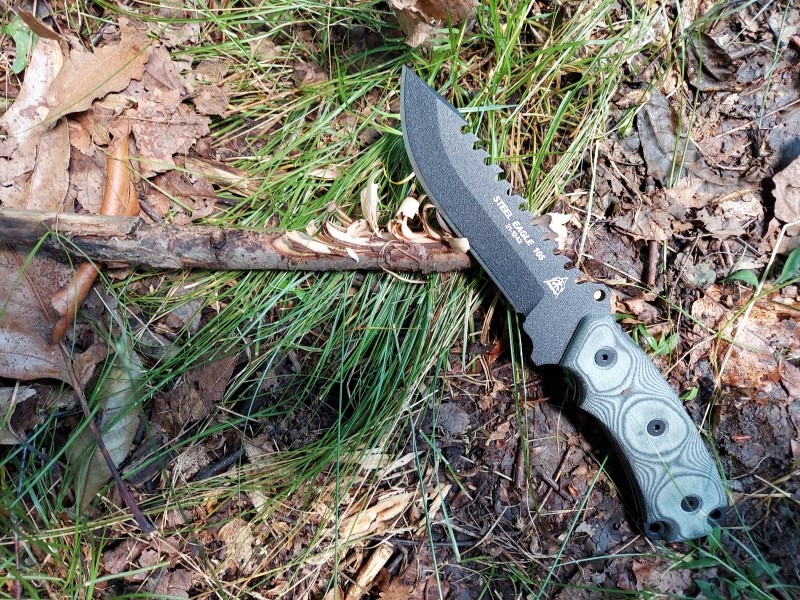
With the sheath, the weight is 13.25 ounces, so it’s not lightweight, but not overly heavy, either. It comes with a very nice Kydex sheath. Retail, as of this writing, is around $138, making this a smart buy.
Emerson PUK (Police Utility Knife)
This one is a simple, straightforward design that handles itself well whether in the urban jungle or the woodlands. The blade length is 3.6 inches and the steel is 154 CM, so it’s easy to sharpen (which is why Emerson uses this steel).
It’s a V-Grind, which is very sharp, and the blade is .125 inches thick, so it’s a stout blade. The G-10 handle is one of the most comfortable knife handles that I’ve ever used, it just melts into my grip. The sheath is Kydex and attaches to a wide range of belt widths. This is a no-nonsense, useful knife that is not large or heavy; it’s rather compact. Retail as of this writing is $265, but they should be available for less on the open market.

Sean O’Hare Badger
This one is amazingly versatile, with a 4.5-inch long blade of 154 CM steel in a drop point configuration. The blade is actually slightly longer because there is a choil in front of the grip so you can choke up on the knife for precision cuts. The blade is flat ground and incredibly sharp. Handle material is green canvas micarta that is done very nice (this is a full custom knife, keep in mind).

This knife will cover the bases in quite a few different categories, and if I had to choose one fixed blade, this would be the one. The sheath is Kydex and the belt clip is ingenious in the way it hooks onto the belt but can also be removed easily.

Depending on the materials used, I believe Sean would charge around $425-$450 for one of these, but don’t quote me on that, prices may have gone up since I’ve last checked. If you want a top-notch fixed blade, check him out online, his products are absolutely stellar.
As with the other categories, there are a ton of other blades out there that would excel at this task, but space, time, and finances prohibit covering them all. These are a few to whet your appetite and get you looking.
Hunting Knives
Skallywag Tactical Hunter
This one has a 2.75-inch long blade of D2 tool steel, which holds an edge nicely. It’s a stout blade and the overall knife is 8.5 inches long, weighing just over 1/3 of a pound. It’s a barebones, no nonsense knife that gets the job done.

A great slicer! This would skin out a deer in no time flat. The handle is G-10 and comfortable. The sheath is Kydex and has a belt attachment that works well. Priced at $75 as this is written, it represents a great deal.
Buck 113 Fixed Blade Ranger
The blade on this guy is 3 1/8 inches long, made from 420 HC. It’s a drop point design and the blade has lots of belly for slicing and skinning. The handle is very comfortable and made from Ebony, so it’s durable too. Comes with a leather pouch sheath that’s well constructed. Retail at this writing is $86.99 and well worth it!

We already spoke about the Buck 110 Folding Hunter and the 112 Ranger folding knives in the EDC category, but they also are perfectly suited for hunting, so rather than beat a dead horse, I’ll just mention them here as being perfect for this category.

Spyderco PM 2 & 3
Despite them not being generally looked upon as “classic hunters,” these knives would do a decent job harvesting game, given their versatile blade shapes. Even the Spyderco Native would do a passable job skinning out game.

A few other fixed blades that could: the O’Hare Badger and the Emerson PUK, just to name a few. Though it wouldn’t be my first choice, the TOPS Steel Eagle 105 could also be pressed into service.
Whether fixed blade or folder, there is a plethora of knives that could work in the Hunting category.
Combat/Defense/Tactical Knives
Here’s where things can get tricky. If you have to (God forbid) use a knife in self-defense, you will likely find yourself in court. You probably don’t want the prosecutor holding up a knife to the jury, stating, “The defendant used this ‘Close-Quarters-Combat-Dragon-Slayer-XYZ Special Forces/SEAL/Ranger/Delta’ knife to do grave bodily harm to my client, who was on his way to rescue a burning school bus full of nuns.”
It might be slightly better if he held up a Buck 110, the all-American knife that has a relatively non-threatening look and every rancher and farmer probably uses. Another analogy might be made using the AR-15 versus the good, ol’ .30-30 lever action.
With that said, certain blades are better suited for self-defense than others.
Emerson CQC-7BW
With a blade length of 3.3 inches of 154 CM steel, the CQC stands for Close Quarters Battle. It is a tanto blade, which many people think is not practical for EDC uses, but it actually slices and scrapes very well. It’s better known for its stabbing ability, which it also does well.

Mine has the Wave feature, which, when hooked onto the pocket of the pants, deploys the knife blade as it’s coming out of the pocket. The handle scales are G-10 for a good grip. Locking is accomplished via a liner lock. This knife has been used by military units the world over. It wouldn’t actually be my first choice for combat, given its smaller size, and I’ve often carried it for EDC purposes. As of this writing, prices for them are around $230.
Emerson Roadhouse
This one is a liner lock with a 3.8-inch blade that has a tanto tip. As with the CQC-7, this knife is useful for EDC tasks, if not a bit large for the job. The blade is made out of 154 CM stainless steel and is stout.

Mine is partially serrated. It’s well suited for combat, at least as far as folding knives go, with a comfortable grip that you can really get ahold of. The tanto blade of the Roadhouse just looks wicked, and it means business. The price on the street as of this writing is around $219.00.
Beyond that, any of the blades listed here could be used for self-defense. If I were in a military environment, my primary combat blade would be of the fixed variety, as they are stronger and faster/easier to deploy than folders. The O’Hare Badger, TOPS Steel Eagle, Emerson PUK, and even the fixed blade Buck would mostly suffice for the role. Combat with knives is not really that complicated, although people sometimes try to make it more complex than it needs to be.



If necessary, most of the folders listed in this article could work for defense, especially the Spyderco Paramilitary 2, given its longer blade length and the hole that makes it quick to deploy. As well, the fact that it clips to the pocket and is easily accessible helps a lot. Naturally, many other knives also meet these criteria.
In Summary
It’s hard to lump a knife into just one category unless it’s a really specialized piece that is a One-Trick-Pony. Quite a few knives here meet the criteria for every category mentioned.
And about those categories: I only named a few. Had I wanted to go down various rabbit holes, I could have mentioned quite a few others. Which I didn’t, because, there’s only so much space here, and my editor has probably already poked pins into a voodoo doll likeness of me in an effort to shut me up!
As I said, part of the fun of getting knives is seeing how many jobs and categories I can get them to overlap and fit into. Who knows…maybe one day we’ll find that one magical knife that Does It All” But I hope not too soon, because I’m having a ball trying out all the knives that I can get my hands on!


